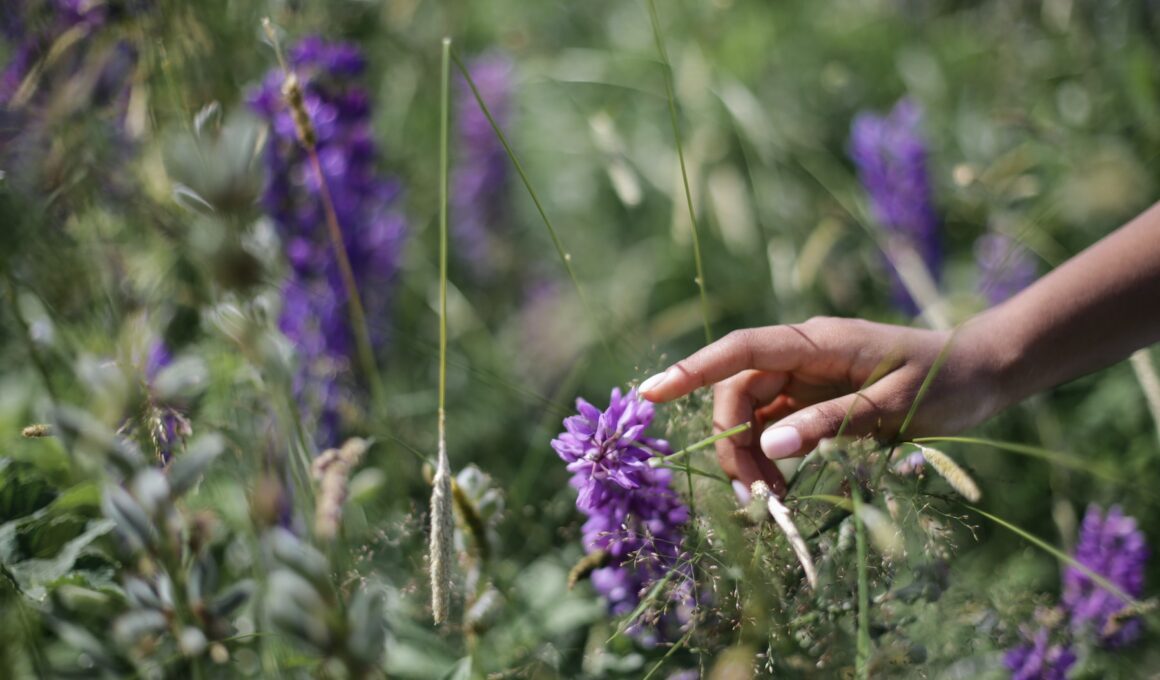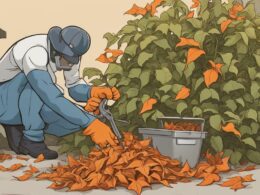Do you have lupins in your garden that have finished flowering and are ready for some pruning? It’s important to know how far to cut them back in order to promote healthy growth and ensure a beautiful display of flowers for the next season.
Cutting back lupins after flowering not only helps to maintain their shape and size, but also encourages new growth and increases the likelihood of a longer blooming period.
Timing is crucial when it comes to cutting back lupins. You don’t want to trim them too soon after flowering, as this can disrupt the plant’s natural cycle and prevent it from storing enough energy for the following year’s growth.
On the other hand, waiting too long to cut back the lupins can result in the plant becoming too woody and overgrown. So, how far should you cut back your lupins and when is the best time to do it? Keep reading to find out.
Importance of Cutting Back Lupins After Flowering
It’s important to give your lupins a little TLC after their beautiful blooms, so they can come back even stronger next season. One of the best things you can do for your lupins is to prune them after they’re done flowering.
Pruning helps prevent diseases and pests from taking hold, as well as promoting healthy growth. Pruning also encourages your lupins to produce more blooms. When you cut back the spent flowers, you’re telling the plant to put its energy into producing more blooms, rather than putting it into producing seeds.
This means that your lupins will produce more flowers the following season, making them even more beautiful. If you don’t prune your lupins after they’re done flowering, they may become overcrowded and start to look unruly.
This can also lead to a decrease in blooms, as the plant will put more energy into producing seeds than into producing flowers. Additionally, overcrowding can lead to diseases and pests taking hold, which can be detrimental to your lupins’ health.
So make sure you take the time to give your lupins the care they need after flowering, and you’ll be rewarded with beautiful blooms for years to come.
Timing of Cutting Back Lupins
Once the vibrant blooms of lupins have faded, it’s time to trim them down for a tidy and healthy garden. But when is the best time to cut back your lupins?
The answer is simple: as soon as the flowers begin to die off, it’s time to prune. This timing allows your plant to direct its energy towards growing a healthy root system and preparing for the next blooming season.
When pruning your lupins, there are a few techniques to keep in mind. First, make sure to cut the stem just above the first set of leaves. This allows for new growth to emerge from the base of the plant. Second, remove any brown or dead flowers to encourage the plant to produce more blooms. Finally, remove any diseased or damaged stems to prevent the spread of disease to other parts of your garden.
These pruning techniques will not only keep your lupins looking tidy, but will also benefit the overall health of the plant.
Benefits of deadheading cannot be overlooked when it comes to pruning lupins. Deadheading is the process of removing spent flowers from the plant. It not only improves the appearance of the plant, but also encourages the plant to produce more blooms.
By removing dead flowers, the plant does not waste energy on seed production and instead directs its energy towards growing more flowers. This means that you will have a longer blooming season and a healthier plant overall.
So, don’t hesitate to deadhead your lupins after pruning to ensure a beautiful and thriving garden.
Do Perennial Lupins Need to be Cut Back After Flowering?
Perennial lupins explained: After flowering, it is advisable to cut back the faded blooms of perennial lupins. This encourages the plant to direct its energy towards producing new growth and promotes a more compact shape. Moreover, removing spent flowers prevents self-seeding, ensuring better control over where these beautiful plants grow in your garden.
How Far to Cut Back Lupins
Make your lupins thrive by pruning them just above the first set of leaves, encouraging new growth and producing more vibrant blooms for your enjoyment.
When cutting back lupins, the goal is to remove the spent flower spikes while leaving as much foliage as possible. This will help the plant to produce more energy for the next growing season, and will also keep the plant looking tidy.
To ensure that your lupins thrive, it’s important to use proper pruning techniques. When cutting back the plant, use clean and sharp pruning shears to make a clean cut. This will help to prevent damage to the plant and reduce the risk of disease. Additionally, it’s important to avoid cutting back too aggressively, as this can harm the plant and reduce its overall health.
In terms of lupin maintenance, cutting back the plant after flowering is just one step in caring for your lupins. It’s important to water the plant regularly, especially during hot and dry weather, and to fertilize the plant in the spring and summer months.
With proper care and attention, your lupins will continue to thrive and bring you joy year after year.
Tips for Cutting Back Lupins
When cutting back your lupins, it’s important to use clean and sharp pruning shears to avoid damaging the plant. Cut at a 45-degree angle to allow for proper water drainage and to stimulate new growth.
Dispose of spent flowers and foliage properly to prevent the spread of disease and pests.
Use Clean and Sharp Pruning Shears
Using clean and sharp pruning shears is crucial when cutting back your lupins after flowering. It’s essential to ensure that your pruning shears are clean and disinfected before use to prevent the spread of any diseases.
You can easily sharpen your pruning shears at home with a sharpening tool or take them to a professional to get them sharpened.
When cutting back your lupins, make sure to use a sharp pair of pruning shears to make clean and precise cuts. Dull pruning shears can damage the plant, making it more susceptible to infections or disease.
It’s also important to clean your pruning shears after each use to prevent any potential disease from spreading to other plants.
By following these simple steps, you can ensure that your lupins remain healthy and beautiful year after year.
Cut at a 45-Degree Angle
Now that you’ve got your clean and sharp pruning shears ready, it’s time to learn the proper cutting technique for lupins after flowering. Don’t just hack away at the plant, but pay attention to the angle at which you make your cuts. Precision is key to ensure your lupins continue to grow strong and healthy after pruning.
To make the perfect cut, hold your pruning shears at a 45-degree angle and carefully snip away at the stem. This technique promotes quick healing and prevents damage to the plant. Precision cutting encourages new growth and helps control the shape of your lupins. Proper pruning techniques also prevent the spread of disease and pests, keeping your garden healthy and beautiful.
Remember, pruning is an important part of maintaining the overall health and appearance of your garden. Take the time to learn proper pruning techniques. By following these simple tips, you can keep your lupins looking their best year after year.
So grab your pruning shears and start snipping away!
Dispose of Spent Flowers and Foliage Properly
It’s important to dispose of spent flowers and foliage properly to maintain the health and beauty of your garden. When lupins have finished flowering, it’s best to cut back the flower spikes to encourage new growth and prevent the plant from putting its energy into seed production.
Once you have cut back the lupins, it’s essential to dispose of the spent flowers and foliage properly. Proper disposal of spent lupin flowers and foliage involves more than just throwing them in the trash.
Lupins are biodegradable, and they can be composted to create a nutrient-rich fertilizer for your garden. However, you must ensure that the lupin plant material is fully decomposed before adding it to your garden.
Improper disposal of spent lupin flowers and foliage can have a negative environmental impact, so it’s essential to take the time to dispose of them properly.
Can I Use a Tree Saw to Cut Back Lupins After Flowering?
Yes, a tree saw is one of the top choices for cutting trees. However, for cutting back lupins after flowering, it may not be the most precise tool. Pruning shears or loppers would be better options for this task, as they allow for more delicate and accurate cuts.
Aftercare for Lupins
Taking care of your lupins after they bloom can help ensure a healthy and vibrant plant for years to come. After the flowers have faded, it’s important to cut back the flower stalks to encourage the plant to produce more blooms and prevent it from going to seed. Use a sharp pair of scissors or pruning shears to cut the stalks down to the first set of leaves below the spent blooms.
In addition to deadheading, fertilizing your lupins can also help promote healthy growth and more blooms in the future. Use a balanced fertilizer, such as a 10-10-10 formula, and apply it according to the manufacturer’s instructions. Generally, it’s best to fertilize lupins in the spring and again in the summer, but be careful not to over-fertilize, as this can lead to excessive foliage growth at the expense of blooms.
Remember to keep an eye out for any signs of pests or disease, such as aphids or powdery mildew, and take action promptly if you notice any issues.
With proper aftercare, your lupins can continue to provide beautiful blooms for years to come.
Frequently Asked Questions
Do lupins need to be cut back every year after flowering?
To maintain healthy and attractive lupins, it’s essential to understand the basics of pruning techniques and lupin care.
While lupins don’t necessarily need to be cut back every year after flowering, it’s recommended to remove the spent flower spikes to encourage new growth and prevent seed formation. This process is known as deadheading and can be done by cutting the stem just above the first set of leaves.
Additionally, it’s beneficial to cut back the entire plant in late summer or early fall to promote a fuller and bushier growth habit.
Proper pruning and care will not only keep your lupins healthy but also enhance their overall appearance.
Can lupins be propagated from cuttings taken during the cutting back process?
Looking to propagate your lupins? Cutting techniques can be an effective way to do so! Lupins can be propagated from cuttings taken during the cutting back process.
After flowering, cut back the stems to just above the foliage. Then, take a cutting from the stem – around 3-4 inches long – and remove the lower leaves. Dip the cut end in rooting hormone and plant in a pot filled with well-draining soil.
Keep the soil moist and in a bright, but not direct, location. After a few weeks, roots should begin to form and your new lupin plant will be ready for transplanting.
With these simple steps, you can successfully propagate your lupins and enjoy their beautiful blooms for years to come.
Will cutting back lupins affect their flowering the following year?
Cutting back lupins after flowering can actually benefit their growth and flowering the following year. Pruning benefits include stimulating new growth and preventing the plant from becoming too leggy or top-heavy.
Timing considerations are important, as cutting back too late in the season can lead to the plant not having enough time to recover before winter. It’s best to cut back lupins in late summer or early fall, before the first frost. This will give the plant ample time to grow new shoots and prepare for next year’s blooms.
So, don’t be afraid to prune your lupins after flowering – it’ll only lead to healthier, more vibrant plants in the long run.
Is it necessary to remove all the spent flowers before cutting back lupins?
When it comes to pruning techniques for lupins, it’s important to consider the benefits of leaving spent flowers on the plant. Not only do they add visual interest to the garden, but they also provide a food source for birds and other wildlife.
However, if you do decide to cut back your lupins after flowering, it’s not necessary to remove all of the spent flowers before doing so. Simply removing the top portion of the stem, where the spent flowers are located, should be sufficient. Just be sure to use sharp, clean pruning shears to avoid damaging the plant.
By using proper pruning techniques, you can help your lupins stay healthy and vibrant year after year.
Can the cuttings from lupins be used for composting?
If you’re wondering what to do with your lupin cuttings after pruning, composting is a great option. Lupin cuttings can be used as garden waste to create nutrient-rich compost for your plants.
Composting helps reduce waste and provides a sustainable solution for garden waste management. To compost lupin cuttings, simply add them to a compost bin along with other organic materials such as leaves, grass clippings, and vegetable scraps.
Over time, the materials will break down and create a nutrient-rich soil amendment that can be used to improve your garden soil. So don’t throw away your lupin cuttings, compost them instead!
Conclusion
Now that you know the importance of cutting back your lupins after they flower, it’s time to get to work.
Remember to wait until the flowers have finished blooming before you start cutting.
When you do cut, be sure to cut the stems down to the first set of leaves. This will help encourage new growth and prevent the plant from becoming too woody.
It’s important to use sharp, clean tools to prevent damaging the plant.
Once you’ve finished cutting, be sure to remove any dead or damaged foliage and give your lupins a good watering.
With proper care and attention, your lupins will thrive and continue to produce beautiful blooms for years to come.








